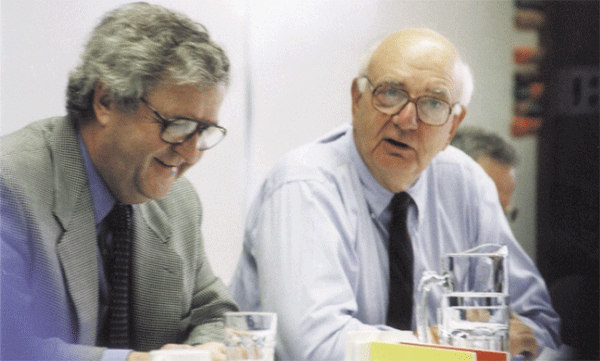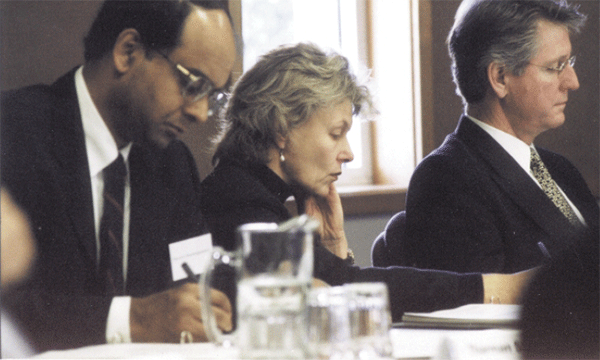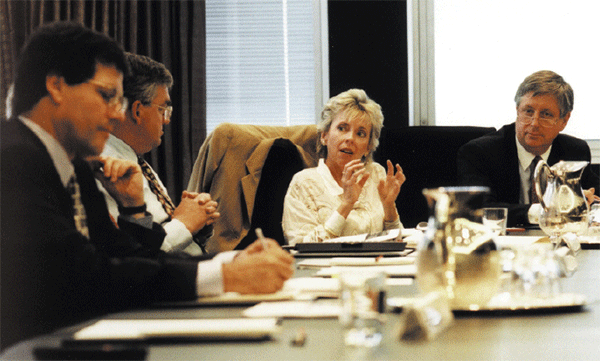Reserve Bank of Australia Annual Report – 2000 The RBA in the Community
An important element of the RBA's task is to explain its role and actions to the community at large and to contribute to community activity in areas which are complementary to its activities. Successful monetary policy requires financial markets to have a thorough understanding of the policy framework, but there also needs to be, in the community as a whole, a broad understanding and acceptance of the logic of policy. The RBA accepts that accountability is part-and-parcel of independence.
Accountability
A central channel for accountability is through appearances before Parliamentary Committees. The Governor and senior officials appeared before the House of Representatives Standing Committee on Economics, Finance and Public Administration on three occasions to answer questions about the conduct of monetary policy and other issues relating to its broader responsibilities, including payments systems. Shortly before the two regular appearances (in Sydney in November 1999 and in Melbourne in May 2000), the Bank published its Semi-Annual Statement on Monetary Policy, giving its detailed assessment of the latest economic and financial conditions. The third appearance before the Committee in Sydney in February 2000, was part of the Committee's Inquiry into international financial market effects on Government policy.
The RBA has also appeared before other Parliamentary Committees on matters where it is seen to have a particular expertise. In May, the Assistant Governor (Financial Markets) appeared at a hearing of the Joint Committee of Public Accounts and Audit, as part of that Committee's examination of an audit report by the Auditor-General into Commonwealth debt management. In June, he appeared at a hearing of the Senate Select Committee on Superannuation and Financial Services.

In conjunction with the various hearings of these Parliamentary Committees, the RBA has provided additional detailed information on subjects of particular interest to the Committees. It provided to the House of Representatives Standing Committee on Economics, Finance and Public Administration papers on bank fees on small businesses (in November), and on bank fees (in May), and to the Joint Committee of Public Accounts and Audit a paper on management of the Reserve Bank's portfolios of financial assets (in May). These papers are now part of the public record.
Senior officers have also presented the RBA's perspective on current issues in various public forums. For example, the Governor gave a talk on ‘Managing the Expansion’ to the Economic Society in Melbourne and another to the Australian Business Economists in Sydney. He delivered the Chris Higgins Memorial Lecture, on ‘Monetary Policy in Economic Expansions’ in Canberra and the R.C. Mills Memorial Lecture on the ‘Stability of the Financial System’ in Sydney. The Deputy Governor spoke on ‘Financial Crises and Globalisation’ at a conference in Canberra organised by The Reinventing Bretton Woods Committee. Three of the Assistant Governors also gave major presentations during the year to interstate audiences.
Interest in Australia among international audiences has been heightened by the Australian economy's good performance over the 1990s, particularly during the Asian crisis. The Governor's talk to Australian Business in Europe, in London in May, was directed primarily at the international investment community. The Deputy Governor spoke on ‘The International Reform Agenda: Unfinished Business’ at the World Economic Forum's 1999 East Asian Economic Summit in Singapore in October. The Assistant Governor (Financial System) gave a presentation on ‘Monitoring Financial System Stability’ to participants from Australia and overseas at the International Banking Summer School in Melbourne in September.
Given the close attention which is now paid to all comments which are made by the Governor, a decision was taken during the year to discontinue a longstanding practice of giving informal, semi-private addresses to small audiences. Often these semi-private audiences were composed of groups of institutional investors from offshore (sometimes in Australia and sometimes overseas), and some Australian market participants and commentators expressed the view that they were being disadvantaged by not having access to remarks which were being made in these gatherings. All the Governor's speeches are now before public audiences and open to the press.

Most of the public presentations by senior officers during the past year were reproduced in the Bank's Bulletin and published on the web site (www.rba.gov.au) at the time the presentations were being given. As has been practice in recent years, the RBA published in January – both in the Bulletin and on the web site – a summary of the economic and financial research undertaken during the previous calendar year. During 1999/2000, nine Research Discussion Papers (RDPs) were published, in hard copy and on the RBA's web site. The RDPs are intended to make the results of current economic research within the RBA available to other economists, by presenting preliminary results of research in order to encourage discussion and comment. To this end, authors of the papers may express their own views, which are not necessarily those of the Bank.
The progressive evolution of the RBA's web site continued during the year. In March, at the time of the release of that month's issue of the Bulletin, the Bulletin statistical tables were for the first time made available on the web site. The tables on the web site are in the same format as published in the Bulletin, but they include historical as well as the most recent data, and they are updated monthly, at the same time as the Bulletin is released. As a result of this expansion in the scope of the web site, there has been a significant increase in the number of visits to the site.
With the increasing trend towards using electronic media as the primary vehicle for publishing information, the Bulletin Editorial Committee was reconstituted into a Publications Committee in April. The chairmanship of the new Committee remains with the Assistant Governor (Economic) and the composition of the Publications Committee, while remaining essentially the same as its predecessor (with representatives from the three policy areas of the Bank, plus the Bank's Secretary), was widened to include the Head of Systems and Technology Department to take account of the expanded focus on electronic methods of publication.

Following the accidental premature release of the 2 February Monetary Policy announcement, the Bank has reviewed publication procedures for market-sensitive information to ensure that it is released in a timely and equitable manner.
The RBA's annual Economic Conference has continued to attract participation by highly regarded economists from around the world. The 1999 conference was held in August on the theme of ‘Capital Flows and the International Financial System’, with presentations from inter alia Paul Volcker, Eisuke Sakakibara, Max Corden and Barry Eichengreen. The theme of the 2000 conference, held in July, was ‘The Australian Economy in the 1990s’, with presentations by a number of Australian economists plus Professor Bradford DeLong from the University of California, Berkeley, and Professor Charles Bean from the London School of Economics. All the presentations at the Conferences are made available on the RBA's web site, and then compiled into a hard-copy conference volume.
Other contributions to academic discussion have involved RBA staff making formal presentations to university audiences. Senior staff from Economic and Financial System Groups have made presentations to students at universities in both Sydney and Melbourne and at the March conference of the New South Wales Economics Teachers.
Financial and Other Contributions
The practice in recent years of making financial contributions to various projects undertaken by Australian universities has continued. This has included the provision of funding for: a monthly survey of inflation expectations undertaken by the Institute of Applied Economic and Social Research at the University of Melbourne (support which has been provided for a number of years); a third, and final, annual contribution, along with a number of other financial institutions, to the Securities Trading and Research Laboratory (‘Starlab’) of the University of New South Wales; and an ongoing quarterly survey of union inflation and wage expectations, organised by the Australian Centre for Industrial Relations Research and Training at the University of Sydney.
Funds were also contributed in the past year towards the running of a number of academic conferences: the 28th Conference of Economists, held at La Trobe University in Melbourne; the annual PhD Conference in Economics and Business (held jointly by the Australian National University and the University of Western Australia); the 12th annual Australasian Finance and Banking Conference, at the University of New South Wales; a conference on International Migration into the 21st Century, at the University of Western Australia; and a conference on banking and finance organised by the University of Melbourne's Centre of Financial Studies. In addition, the RBA undertook to fund, for two years, the costs of distributing to a core group of policy-makers in Papua New Guinea and the Pacific Islands, the Pacific Economic Bulletin, produced by the Asia Pacific School of Economics and Management at the Australian National University. Financial assistance was also provided to the Sir Roland Wilson Foundation, which encourages study and research, through graduate programs at the Australian National University, in areas associated with the career of Sir Roland who was Secretary to the Treasury from 1951–66 (and member of the Reserve Bank Board). The RBA also continued its support for three places at the University of Technology, Sydney in information technology. Outside the academic field, the RBA provided a financial contribution to the costs of running of the conference, held in Sydney in May, of the Asia/Pacific Group on Money Laundering (which is part of the Financial Action Task Force, formed under the auspices of the G7 Economic Ministers). It also continued its practice of making an annual contribution to the Group of 30 to support its program of research and publications on issues in international finance. A sum of $200,000 was paid to the Sydney City Council to assist in upgrading the section of Martin Place outside the RBA's Head Office building; the same amount was paid in 1998/99.
As part of its broader community relations, the RBA chairs the Small Business Finance Advisory Panel. This Panel, established in 1993, draws on a number of small and medium-sized businesses across Australia from a wide spectrum of industries to provide advice to the Bank on issues relating to the provision of finance to the sector. These annual meetings provide a useful opportunity to assess the conditions faced by small businesses.
During the year, the RBA contributed a total of $24,800 to 27 charitable organisations. It is a corporate sponsor of the annual ‘Work-A-Day 4 Kids’ fund-raising event, which is organised under the auspices of the Financial Markets Foundation for Children. The Governor is Chairman of the Foundation, which draws support from staff members of institutions in the financial markets and related fields and which raises money to be applied to research into medical and social problems affecting children.
Statutory Obligations
Equal Employment Opportunity
As required under the Equal Employment Opportunity (Commonwealth Authorities) Act 1987, the RBA reports to the Australian Parliament each year on its Equal Employment Opportunity (EEO) program; the report for 1998/99 was tabled in October 1999. The Report includes details of the Bank's EEO Plan which concluded at end June 2000. A new Plan was developed to operate for the following year; the new Plan carries forward the broad objectives of the previous Plan, but incorporates new strategies to achieve those objectives.
Health and Safety, Compensation and Rehabilitation
The RBA is required by Section 74 of the Occupational Health and Safety (Commonwealth Employment) Act 1991 and Section 107 of the Safety, Rehabilitation and Compensation Act 1988 to report on any health and safety matters as they relate to the Bank.
A major focus of the Occupational Health and Safety Plan during the year was to implement progressively a new system for identifying, assessing and controlling hazards in the RBA's workplaces. The system was successfully implemented in the remaining branch offices and a start was made on Head Office areas during the year. In support of this program, the Health and Safety Policy has been reviewed and reissued.
In 1999/2000, one Occupational Health and Safety Audit was undertaken by representatives from the Safety Rehabilitation and Compensation Commission compared to two audits in the previous year. The positive result from this audit continued the trend of the earlier audits and is welcomed for acknowledging the contribution being made by staff in promoting sound health and safety practices.
Only a small number of new claims for workers' compensation were received during the year. Most were for injuries of a minor nature, and claims management and rehabilitation arrangements were effective in determining claims quickly and returning staff affected to work with little lost time. The closure of branches has reduced the RBA's risk profile somewhat and, with an active hazard management program being implemented, the scope for work-related injuries should continue to diminish.

The RBA's performance in managing claims in terms of its licence to self-insure was also the subject of an audit by the Safety Rehabilitation and Compensation Commission. Partly as a result of a number of initiatives implemented last year, the audit reported a high level of compliance with obligations under the Act and conditions of the RBA's licence to self-insure. One of these initiatives involves contracting out reviews of primary determinations made by the RBA to another licensed authority. This decision will reduce overheads involved in managing the small number of determinations which are disputed.
Freedom of Information
Section 8 Statement
The RBA is an exempt agency under the Freedom of Information Act 1982 in respect of documents concerning banking operations (including individual open market operations and foreign exchange dealings) and exchange control matters.
Organisation and functions: The RBA is Australia's central bank. It was established by Commonwealth legislation in 1911. Its functions, powers and responsibilities are specified in the Reserve Bank Act 1959, the Banking Act 1959, the Financial Corporations Act 1974, the Commonwealth Authorities and Companies Act 1997, the Payment Systems (Regulation) Act 1998, and the Payment Systems and Netting Act 1998 and in Regulations made under those Acts. An organisation chart appears at the end of this Report.
Categories of documents: Lists of publications, including speeches, articles, occasional papers, information booklets, conference volumes, regular media releases and other publications, are published from time to time in the Reserve Bank Bulletin; this information is also included on the web site (www.rba.gov.au). Other documents held are in the form of working notes and files covering policy and operational matters, statistical data, personnel, premises and general administration.
Facilities for access and Freedom of Information procedures: Inquiries under the Freedom of Information Act, including requests for access to documents, should be directed to the Secretary, Head Office, or the Managers of branches (in Adelaide and Canberra). Applications should be accompanied by the application fee (currently $30). Facilities to inspect documents to which access has been granted are available.
Section 93 Statement
Two requests for access to documents under the Act were received in 1999/2000, compared with three in the previous year. One request was withdrawn before it was processed and access to the documents sought was denied for the other request. There were no applications for internal review and there was one application for review by the Administrative Appeals Tribunal, relating to a request received in 1998/99. The cost of administering the Act in 1999/2000 is estimated to have been approximately $116,900, compared with approximately $67,100 in the previous year; application fees of $30 and charges of around $3,780 were collected by the Bank.